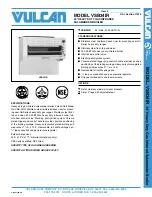
CB FALCON
750-265
78
Periodic Data Polling Messages
The LL master will poll to discover all the slave devices when it
starts up. Thereafter it polls the known devices to make sure
they are still present and to obtain updated status information.
It also periodically polls the entire slave address range to
discover any new slave devices.
A polled slave unit is read to determine the values of the
following data items:
a. The slave's type (compatibility) as indicated by the
LL - Slave type
b. The slave enable status LL - Slave enable
c. The slave mode as set in LL - Slave mode
d. The slave sequence order as set in LL - Slave
sequence order
e. LL - Demand-to-firing delay: mm:ss or None
See Table 37.
f.
CT - Burner run time. See Table 37.
Slave Control Messages
After a slave device has been discovered, the LL master sends
each slave unit a command message.
There are 5 commands that might be sent:
•
DnFnM0: Demand=no, Run off-cycle fan=no,
Modulation=0%.
The LL master sends this message to all LL slaves when
none of these are firing. All slaves are commanded to turn
off and remain off.
•
DnFyM0: Demand=no, Run off-cycle fan=yes,
Modulation=0%.
The LL master sends this message to slaves that are off,
whenever any slave is firing (due to either LL master control
or independent operation).
•
DsFnM0 or DsFyM0: Demand=suspend, Run off-cycle
fan=y/n, Modulation=0%
The LL master sends this message to request a burner to
recycle and remain in Standby if it has not yet opened its
main valve (e.g. it is in Prepurge or PFEP) but to keep firing
if it has reached MFEP or Run.
This message is used to abort the startup of a slave that is not
yet firing (because demand went away just before it was firing),
but to keep it on if it actually is firing (the LL master will
discover what happened in a subsequent status response).
The LL master also sends this message to a slave that is
OnLeave. (This ensures that if the slave is firing when it returns
to LL master control, it will stay that way until the master has
decided whether to use it; or conversely, if the slave stops firing
for some reason that it will not start up again until the LL
master has requested this.
In either case, the command will be DsFyM0 to turn on the off
cycle fan if any other slave burners are firing, or DsFnM0 to
turn the fan off if the slave is the only slave that might (or might
not) be firing.
•
DyFnM0-100: Demand=yes, Run off-cycle fan=no,
Modulation=0-100%
The LL master sends this message to turn the burner on
and to assign the burner’s firing rate.
If the commanded modulation rate is less than the burner’s
minimum modulation rate, then the burner should always
operate at its minimum rate.
SlaveState States
Recovering A slave that is recovering is checked once per
second. If any of the following are true:
DataPollFaultCounter
non-zero
StatusReadFaultCounter
non-zero
AbnormalFaultCounter
non-zero
then the slave's RecoveryTimer is cleared (it has not yet begun
to recover). If the RecoveryTimer reaches the RecoveryTime
then the slave has recovered and the SlaveState is changed to
Available. Each time it is checked (once per second) the
slave's RecoveryLimitTimer is also incremented and if the
slave has not yet recovered when this timer reaches the
RecoveryTimeLimit then:
If the slave is not enabled for the LL master or if its
DataPollFaultCounter or StatusReadFaultCounter is non-zero,
its SlaveState is Set to Unknown (which logically removes it
from the slave table). Otherwise the RecoveryLimitTimer is
cleared which starts a new recovery measurement and the
slave remains in recovery (indefinitely).
Available
A slave in the Available state remains that way until
the Stager moves it into the AddStage state or the
ProcessSlaveStatus action moves it to some other state.
AddStage
A slave in the AddStage state remains that way until
the ProcessSlaveStatus moves it to Firing or some other state,
or the Stager times out and moves it into the Recovering state
if it fails to fire.
SuspendStage
A slave in the SuspendStage state remains
that way until the ProcessSlaveStatus moves it to some other
state, or the Stager times out and moves it into either the Firing
or the Available state.
Firing
A slave in the Firing state remains that way until the
ProcessSlaveStatus moves it to some other state, or the
Stager drops the stage and moves it into the Available state.
Table 36. Data Polling Parameters.
Parameter
Comment
LL - Demand-to-firing delay
mm:ss or None
This delay time is needed by the LL master to determine the length of time to wait between
requesting a slave to fire and detecting that it has failed to start. It should be set to the total
time normally needed for the burner to transition from Standby to Run, including such things
as transition to purge rate, prepurge time, transition to lightoff rate, all ignition timings, and
some extra margin.
CT - Burner run
This parameter will be needed if measured run-time equalization is being used.
Summary of Contents for CFC-1000
Page 35: ...Section 2 Installation Part No 750 263 2 21 Figure 2 23 Gas Piping ...
Page 47: ...Section 2 Installation Part No 750 263 2 33 Figure 2 41 Electrical Connection Diagram ...
Page 49: ...Section 2 Installation Part No 750 263 2 35 Figure 2 43 CFC Wiring Diagram dual fuel units ...
Page 50: ...Section 2 Installation 2 36 Part No 750 263 ...
Page 70: ...Section 3 Stack and Intake Vent Sizing and Installation 3 20 Part No 750 263 ...
Page 102: ...Section 4 CFC Commissioning 4 32 Part No 750 263 ...
Page 108: ...Section 5 Service and Maintenance 5 6 Part No 750 263 ...
Page 113: ...Section 6 Parts Part No 750 263 6 5 Figure 6 3 Casing Table 6 5 Casing parts ...
Page 117: ...Section 6 Parts Part No 750 263 6 9 Figure 6 7 Electrical assemblies single fuel ...
Page 123: ...APPENDIX A CB FALCON CONTROLLER ...
Page 124: ......
Page 244: ...CB FALCON 750 265 120 ...
Page 245: ...APPENDIX B CB FALCON PLUG IN MODULE ...
Page 246: ......
Page 250: ......
Page 251: ...APPENDIX C GAS VALVE ...
Page 252: ......
Page 269: ...APPENDIX D CB FALCON MODBUS COMMUNICATION ...
Page 270: ......
















































